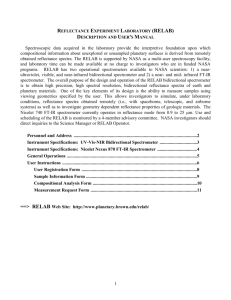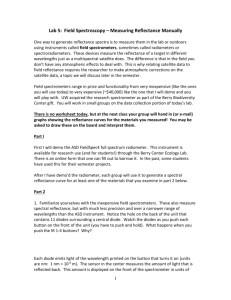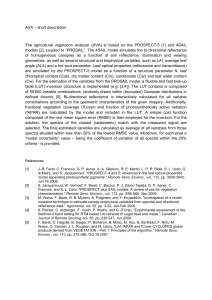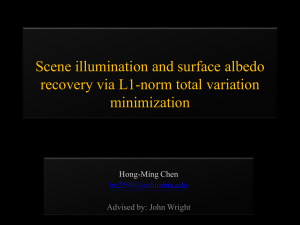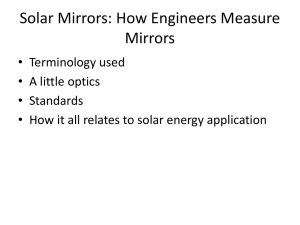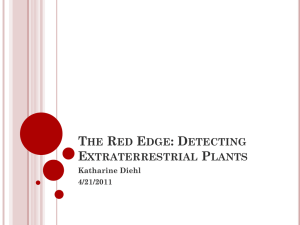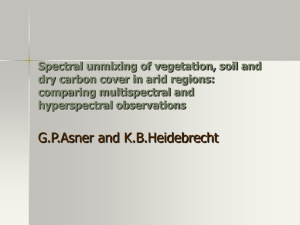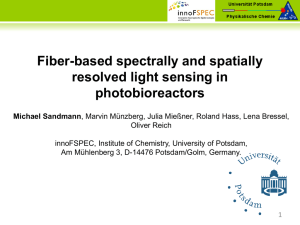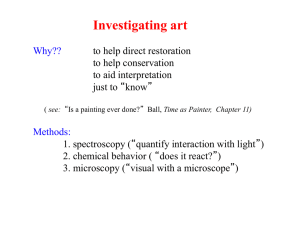RELAB_UserManual_201.. - Brown University Planetary Geosciences
advertisement
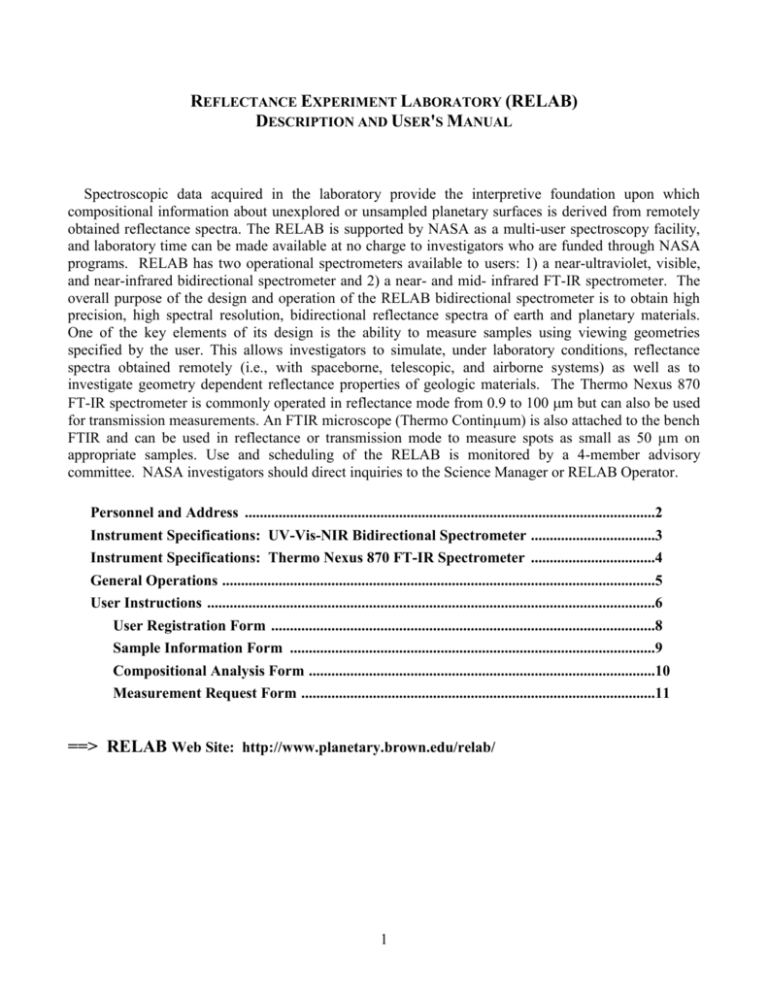
REFLECTANCE EXPERIMENT LABORATORY (RELAB) DESCRIPTION AND USER'S MANUAL Spectroscopic data acquired in the laboratory provide the interpretive foundation upon which compositional information about unexplored or unsampled planetary surfaces is derived from remotely obtained reflectance spectra. The RELAB is supported by NASA as a multi-user spectroscopy facility, and laboratory time can be made available at no charge to investigators who are funded through NASA programs. RELAB has two operational spectrometers available to users: 1) a near-ultraviolet, visible, and near-infrared bidirectional spectrometer and 2) a near- and mid- infrared FT-IR spectrometer. The overall purpose of the design and operation of the RELAB bidirectional spectrometer is to obtain high precision, high spectral resolution, bidirectional reflectance spectra of earth and planetary materials. One of the key elements of its design is the ability to measure samples using viewing geometries specified by the user. This allows investigators to simulate, under laboratory conditions, reflectance spectra obtained remotely (i.e., with spaceborne, telescopic, and airborne systems) as well as to investigate geometry dependent reflectance properties of geologic materials. The Thermo Nexus 870 FT-IR spectrometer is commonly operated in reflectance mode from 0.9 to 100 m but can also be used for transmission measurements. An FTIR microscope (Thermo Continµum) is also attached to the bench FTIR and can be used in reflectance or transmission mode to measure spots as small as 50 µm on appropriate samples. Use and scheduling of the RELAB is monitored by a 4-member advisory committee. NASA investigators should direct inquiries to the Science Manager or RELAB Operator. Personnel and Address .............................................................................................................2 Instrument Specifications: UV-Vis-NIR Bidirectional Spectrometer .................................3 Instrument Specifications: Thermo Nexus 870 FT-IR Spectrometer .................................4 General Operations ...................................................................................................................5 User Instructions .......................................................................................................................6 User Registration Form ......................................................................................................8 Sample Information Form .................................................................................................9 Compositional Analysis Form ............................................................................................10 Measurement Request Form ..............................................................................................11 ==> RELAB Web Site: http://www.planetary.brown.edu/relab/ 1 RELAB ADDRESS: McMillan Hall Department of Earth, Environmental and Planetary Sciences Brown University Box 1846 (or 324 Brook Street) Providence, Rhode Island 02912 Fax (401) 863-3978 PERSONNEL: Prof. Ralph E. Milliken, Science Manager (401) 863-1118 ralph_milliken@brown.edu Dr. Takahiro Hiroi, Operator (401) 863-3776 takahiro_hiroi@brown.edu Mr. Bill Patterson, Engineer (401) 863-1449 patterson@engin.brown.edu 2 INSTRUMENT SPECIFICATIONS: UV-VIS-NIR BIDIRECTIONAL SPECTROMETER Operating Spectral Range: Nominal (0.32 to 2.55 µm); Possible (0.3 to 2.6 µm) Mode Range (µm) A B C D 0.30-0.42 0.40-0.85 0.60-1.80 1.70-2.60 Resolution (nm) Grating Detector Light source < 1.7 < 1.7 < 3.4 < 6.8 1200 1200 600 300 Photomultiplier Photomultiplier InSb InSb Xenon Halogen Halogen Halogen Sampling Interval: 5 or 10 nm standard, 1 nm minimum. Precision: Instrumental error is less than 1/4 % in reflectance. Geometry: Bidirectional reflectance; Spectral goniometry. Incident and reflected beam can each be varied from normal to 70. (-10 < i < 70; -70 < e < 70). Phase angle minimum 12, maximum 140. Sample: Particulate sample or soil (reflectance): Measured horizontal and uncovered (normally rotated slowly). Optimal sample amount is 500 mg. Sample should be no smaller than 20 mg. Sample should be no larger than 10 g. Chip or rock (reflectance): Measured horizontal and uncovered on a height-adjustable stage. Smallest reliable spot size is ~1.5 mm. Maximum sample diameter is 10 cm (2.5 cm if it is to be spun). Thin section (reflectance or transmittance): Measured horizontal on halon (reflectance) or on an aperture (transmittance). Regions to be measured should be no smaller than 1.5 mm. Surface should be polished and clean (no carbon coating). Reference Standard: Halon (pressed) or Spectralon (by Labsphere). Corrections based on the NBS calibration and relative measurement to diffuse gold (at longer than 2 µm in wavelength) are applied automatically. Light Source: Quartz halogen or Xenon lamp. Oriel monochromator. Optics: Order sorting filters, front surface mirrors, depolarizer, apertures. Typical Run Time: Measurements over a spectral range of 0.32 to 2.55 m at 5 nm sampling interval take ~2 hours per sample. 3 INSTRUMENT SPECIFICATIONS: Thermo Nexus 870 FT-IR SPECTROMETER Operating Spectral Range: Nominal (1.0 to 50 m) Possible (0.8 to 200 m) Mode Range (m) Light Source Beam Splitter Detector A A* B C 1.0– 4.7 0.9– 4.5 1.3 - 28 14.3-200 Quartz Quartz Glowbar Glowbar Si-on-CaF2 Si-on-CaF2 Ge-on-KBr Solid substrate TE cooled DTGS LN2 cooled InSb TE cooled DTGS DTGS Resolution: 16, 8, 4, 2, 1 or 0.5 cm-1 Default: 4 cm-1 Geometry: Diffuse reflectance: Biconical, off-axis for Pike sample holder Transmission: normal incidence (collimated) Sample: Particulate sample or soil (reflectance): Measured horizontal and uncovered in purged (H2O, CO2 free) environment. Desired samples amount is 50 - 500 mg. Sample should be no smaller than 20 mg. More than 1 g is unnecessary. Multiple samples can be measured in sequence (same environment) Chip (reflectance): Measured horizontal and uncovered. Regions to be measured should be no smaller than 1 mm. Maximum size is 1 cm in height and 3 cm in diameter. Thin section and single crystal (transmission): Measured vertical, attached to an appropriate aperture board. Regions to be measured should be no smaller than 1.5 mm. Surface should be polished and clean (no carbon coating). Reference Standard: Brushed diffuse gold (reflectance) Blank (transmittance) Additional Attachments: Pike AutoDiff Diffuse Reflectance Autosampler Continuµm Microscope system Transmission mode currently operational Reflectance mode (with 2-D capabilities) being tested. Software: OMNIC, Atlµs [new] 4 GENERAL OPERATIONS Use of the RELAB should be initially arranged through the Science Manager. New Investigators must fill out the attached User Registration Form. All investigators should provide information on each sample to be measured using the attached Sample Information Form and Compositional Analysis Form if chemical or mineral composition is available. A completed Measurement Request From must be provided for each set of samples to be measured under a common measurement condition. This information is very important in order to maintain a useful and up-to-date data base of spectroscopic data. Bidirectional Spectrometer: Powders, chips, or slabs can be measured using the RELAB bidirectional spectrometer. Although sample dishes come in various sizes, the smallest sample that can be accurately handled is about 20 mg, while the optimum sample size is about 500 mg. In all cases it is desirable for the samples to be optically thick over the wavelength region of interest for reflectance measurements. The standard sample dish for the bidirectional spectrometer is aluminum coated with black teflon. Its reflectance is less than 3% throughout the entire spectral range of the bidirectional spectrometer. For analysis of heterogeneous samples, viewing optics include precision apertures for measurements from broad sample areas up to 1 cm in diameter down to areas as small as 1 mm in diameter. To initiate a data run the USER must supply and specify the following run parameters: (a) sample name and properties; (b) angle of incidence (light source) and angle of emission (reflectance); (c) wavelength range (start and stop); and (d) sampling interval. Nominal settings are provided. Based on these run parameters specified by the user, the RELAB Operator configures the system and performs all the data acquisition. A complete spectrum from 350 to 2550 nm at 5 nm sampling interval requires about 2 hours of laboratory run time per sample, depending on sample characteristics. At the end of a run, values for the sample signal, the standard signal, the offset, the ratio of sample/halon (after offset subtraction), and the standard deviation of signal variance during integration on the sample are recorded on disk in a file with all run parameters and text. These data files, each identified by a unique measurement ID, become part of the database collection. NBS calibration of halon is a multiplicative correction to the ratio data, producing absolute reflectance values for the sample. FT-IR Spectrometer: A Nicolet Nexus 870 FTIR spectrometer is operational for samples of particulate samples using a PIKE AutoDiff multi-sample attachment. Infrared [off-axis] biconical reflectance spectra are normally produced relative to a gold standard. Infrared spectra may be scaled to and merged with bidirectional reflectance spectra to produce continuous spectra from 0.3 to 26 µm. The PIKE multi-sample biconical reflectance attachment is normally requested by outside users as the standard mode for mid-IR data. Use of the Nicolet Continuµm microscope is available as well, but use of this instrument requires training and/or piror experience. Contact the RELAB science manager or operator for information on the use of the Continuµm FTIR microscope. 5 USER INSTRUCTIONS 1) After the initial contact with the RELAB Science Manager to arrange use of the facility, users should contact the RELAB Operator directly to schedule samples to be measured. Investigators should carefully select the most appropriate sample preparation and RELAB configuration for their specific science requirements. If a user is uncertain of measurement strategy, he or she should contact the RELAB Operator or Science Manager for advice or suggestions. [During periods of heavy use of the facility, requests for extensive numbers of spectra may be given lower priority in the measurement queue, therefore it is important to prioritize measurements in any large request.] 2) Investigators (and/or their students) should fill out the attached User Registration Form with up-todate information. Sample IDs assigned at the RELAB use the investigators' three initials. If you have published work using RELAB spectra, please also include a publication list. These will be included in a public spectroscopy bibliography on the RELAB website. (It is unnecessary to send references already included.) 3) For each set of samples to be measured under common conditions (same geometry, wavelength range, sample interval, etc), the investigator is requested to fill out the attached Measurement Request Form. It includes information to specify the type of measurement to be made in the RELAB. a) Applicable Samples: Identify all the submitted sample names which are to be measured under a common measuring condition described in the form, or write "All". b) Research Type: For accounting purposes, circle at least one category that accounts for support of this research, and please include NASA award number when applicable. The research type should reflect the NASA involvement of the PI/CoI or Sponsor. c) Wavelength Range and Sampling Interval or Resolution: Choose one of standard values or specify. d) Geometry: Incidence and emergence angles are measured from the vertical direction in positive and negative values of degrees (negative values are on the opposite site). For example, a geometry with source light at 30 inclination and detector at 20 inclination from the vertical direction would be (30, -20) which makes 50 phase angle. Phase angle must be 12 or larger for the Bidirectional Spectrometer and all measurements are currently made in the plane of scattering. Geometry for the FTIR Spectrometer is fixed, with broad conical incidence and reflectance at (30, -30), but out of the plane of scattering. e) Date Desired: Indicate the date spectral data need to be completed. f) Public Release Date: Specify when spectroscopic data on this sample can be included in a public data base available to other investigators in digital form. Maximum period is three years. Default is immediate release. g) Data Transfer Preference: All files and data will be sent to the user electronically (e.g., e-mail). 6 4) For each sample the investigator must fill out the attached Sample Information Form. The information requested includes: a) Sample Name: Formal name or the investigator's name for the sample (can be used in a database search). b) Origin: The geographical site from which the sample was obtained or where it was prepared. If it is extraterrestrial, provide appropriate information - Meteorite fall/find location, Apollo lunar site, etc. c) Location: Where the sample will be (semi)permanently stored. d) Project Topic: Purpose for measuring the samples; general application. e) Comment: General comments about the sample and/or its history. f) Texture: Powder, slab, coarse-grained sand, fine-grained soil, thin section, etc. g) Minimum and Maximum Particle Size: For particulate samples, the maximum and minimum (if known) particle sizes in micrometers. h) General Type, Type, Subtype: Three levels of sample description in addition to Origin. See example below (multiple keywords are allowable in both the Type and Subtype fields). Descriptive examples: General Type Mineral Mineral Rock Rock Soil Soil Meteorite Experimental Man-made Biological Type Silicate Carbonate Igneous, Plutonic Metamorphic Sand Mare Achondrite Heated Mixture Plant Subtype Pyroxene, Enstatite Calcite Granite Gneiss Quartz Bulk, Immature Basaltic, Eucrite Basalt Olivine, Enstatite Maple Leaf 5) Whenever available, modal mineralogy for the sample and/or chemical analysis for either the bulk sample or for individual mineral constituents should be provided on the Compositional Analysis Form. This important information will be stored in a separate file linked to the sample. 6) Samples should be sent to the RELAB Operator with completed forms and any other necessary instructions. Although not necessary, any NASA investigator is welcome to visit the RELAB at Brown University to prepare their samples for measurement in person and to use available data analysis tools. This should be prearranged to prevent schedule conflicts. A small office is available for visitors. 7) Data products are sent to the investigator (digital copy). Special requirements should be discussed with the RELAB Operator. 8) RELAB forms are downloadable in PDF form from our web site along with Microsoft Word files. Contact the RELAB Operator if there are any problems downloading the forms. 7 User Registration Form NASA-funded projects have access to RELAB at no charge to User. Each group of measurements must be accompanied by Measurement Request Forms. Principal Contact: Date _________________________________ Full Name: First Middle Initial Last Affiliation: Mailing Address: E-Mail Address: Phone: Fax: Secondary (or Student) Contact: Full Name: First Middle Initial Last Affiliation: Mailing Address: E-Mail Address: Phone: Fax: * For RELAB use: PI Code: ______ ______ ______ SI Code: ______ ______ ______ 8 Sample Information Form (One for each sample) Investigator: Sample Name: Origin: Location: Project Topic: Comment: Texture: m Particle Size: (Minimum) (Maximum) General Type: Type: Subtype: Is compositional information available? ( ) Yes ( ) No (If yes, please also submit Compositional Analysis Form.) Priority Level: (used in Measurement Request Form) * For RELAB use: MM Analysis #: Bulk Chem. #: ID: ___ ___ - ___ ___ ___ - ___ ___ ___ - ___ ___ ___ ___ PI: ___ ___ ___ SI: ___ ___ ___ PO: 9 Compositional Analysis Form (One for each sample if available) Investigator: Sample Name: Text (identify facility and/or investigator performing analysis): Chemical Analysis (wt%): SiO2: % TiO2: % Al2O3: % Cr2O3: % V2O3: % Fe2O3: % FeO: % CoO: % NiO: % MnO: % MgO: % ZnO: % CaO: % Na2O: % K2O: % P2O5: % : % : % : % : % Include minor or trace elements information on a separate sheet. Modal Mineralogy: Mineral / Component (wt/vol) % Mineral / Component If available, provide chemical analysis for individual minerals on separate sheets. * For RELAB use: Sample ID: M Mineral #: C Analysis #: 10 (wt/vol) % Measurement Request Form (One for each group or subgroup of samples) Investigator Name: Applicable Samples: Research Type (circle at least one): Exobiology LARS LDAP MDAP Active missions Student MFRP NSF PGG DDAP Mission planning Cosmochemistry NASA-Foreign Astronomy SSERVI Proposal preparation Other: ______________________ NASA PI/CoI or Sponsor (if different from Investigator) : Bidirectional Spectrometer (* Standard parameters) Wavelength Range: ( )* 0.32-2.55 µm ( ) 0.3-2.6 µm ( ) Other Sampling Interval: ( )* 10 nm ( ) 5 nm ( ) Other ( )* (30, 0) ( ) Other Geometry (incidence, emergence angles): FT-IR Spectrometer (* Standard parameters) Wavelength Range: ( ) 1-4 m Wavenumber Resolution: ( )* 2-25 µm ( ) 1 cm-1 ( ) 2 cm-1 ( ) 17-50 µm ( ) Other ( )* 4 cm-1 ( ) Other Schedule (* Maximum and default) Date desired for the priority levels specified in the Sample Information Forms Priority Level: Date Desired: Public Release Date: ( ) Immediate ( ) 1 Year 11 ( ) 2 Years ( )* 3 Years EW SSW
